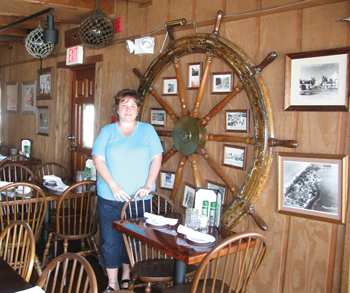Enjoy the view and the food at Bridge Tender Inn

SUN PHOTO/LOUISE BOLGER
Sue Shinka is the manager of the Bridge Tender Inn, which
was built as the Bayside Inn before the first bridge to
the Island was built in 1922.
Why is it that food always tastes better when eaten near the water? Is it the food, is it the view or is it the relaxed tranquility we seem to get lulled into. Whatever the reason, The Bridge Tender Inn on Bridge Street in Bradenton Beach has been making sure their customers are relaxed and tranquil for more than 24 years.
In 1917, Bradenton Beach was nothing more than a small settlement of hearty folks living near the water. One of these first settlers started the area's first commercial enterprise by building the Bayside Inn, which eventually became today's Bridge Tender Inn & Dockside Bar.
In 1922, when the first wooden bridge was built to the Island, it ended at the doorstep of the Bayside Inn, the hub of Bradenton Beach. Decorating the walls of the main dining room at the Bridge Tender are pictures of those early days donated by customers throughout the years, enhancing the nautical theme.
Although Bridge Street has evolved through the years with the addition of new buildings, shops and pier renovations, the one thing on the street that hasn't changed in more than two decades is the Bridge Tender Inn & Dockside Bar. The establishment still offers the same high quality fresh food that keeps locals, and what Manager Sue Shinka calls vacationing locals, coming back year after year.
General Manager Johnny Maschino credits the Bridge Tender's long-term, consistent staff as part of the restaurant's popularity. He, Sue Shinka, Chef Marcus Vega and most of their wait staff all have more than 10 years with the Inn. Returning customers frequently ask to be seated at their favorite waiter or waitress' table.
The Bridge Tender's menu encompasses everything from light bites like grouper fingers, mussels and coconut shrimp, to complete dinner specials and entrees including beef, chicken and Fish Your Way, where you choose your fish and how you would like it prepared with one of the Bridge Tender's signature sauces. There are also sandwiches for lunch and dinner, side dishes, soups and salads, pasta and a kids' menu. Prices are moderate and everything on the menu is available in either the main dining room or in the Dockside Bar.
And speaking of the Dockside Bar, it's a hopping place seven days a week with entertainment by local performers like Doug Bidwell, Larry Stokes and Larry Rich, as well as big screen TVs for sporting events. Of course the whole point of having a Dockside Bar is to be able to bring your boat right up to the dock.
The Bridge Tender Inn & Dockside Bar invites boaters to come by sea where they will find two docks available for their vessels. Just turn at Intracoastal Marker 49 and follow the channel markers in. Remember not to boat too close to the end of the pier because it usually is jammed with fishermen. And if you're coming by land, the Bridge Tender has ample parking on its premises.
Johnny Maschino says the secret to the Bridge Tender's success is not that complicated, "Good food, good product, and good bang for the buck." That combined with a Dockside water view that puts us under the spell of the sea and the salty air makes for a delicious and irreplaceable dining experience.
Bridge Tender Inn & Dockside BAR
135 Bridge Street
Bradenton Beach
778-4848
Sunday-Thursday
11:30 a.m. to 11 p.m.
Friday & Saturday
11:30 a.m. to midnight
All major credit cards accepted


